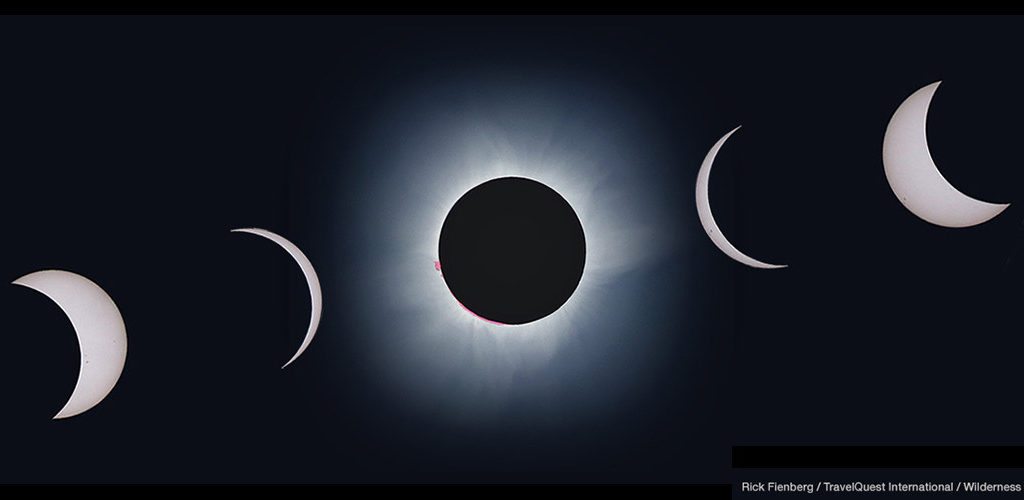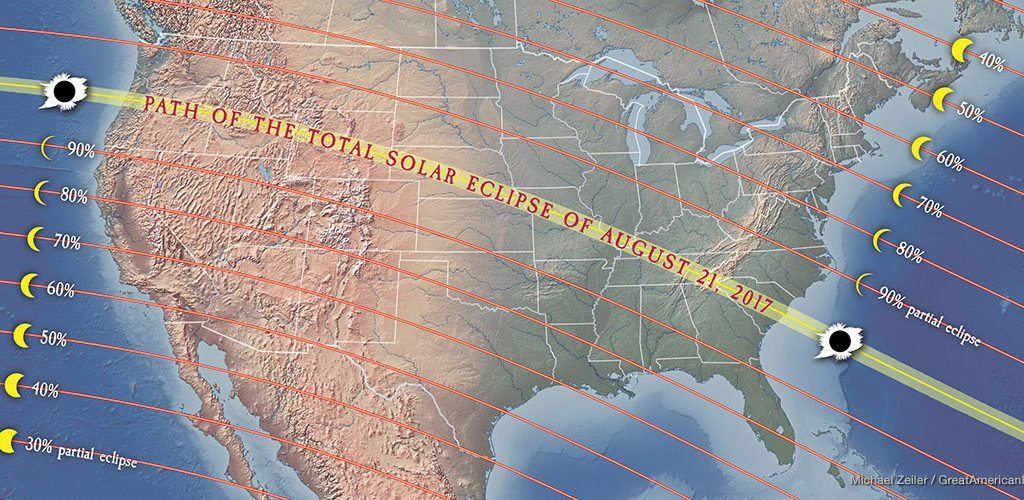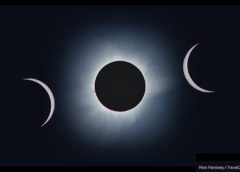Total Eclipse of the Sun Crosses the U.S. from Oregon to South Carolina on August 21st

WASHINGTON, June 20, 2017 /PRNewswire-USNewswire/ — Astronomers and solar physicists will be out in force during this summer’s total eclipse of the Sun (https://eclipse.aas.org/eclipse-america), now just two months away. They’ll use ground-based telescopes, airborne instruments, and orbiting satellites to shed new light on some of the Sun’s best-kept secrets. But if there’s one thing the American Astronomical Society (AAS) wants you to know, it’s that the August 21st solar eclipse is much more than a scientific bonanza — it’s an opportunity for ordinary people from all walks of life to experience what is arguably nature’s most awesome spectacle.
When the Moon totally blocks the Sun’s bright face (https://eclipse.aas.org/eclipse-america/eclipse-experience), the landscape darkens suddenly, bright stars and planets shine forth in a twilight-blue sky, pastel hues of sunset glow around the horizon, the temperature drops noticeably, and birds and animals behave as if night has fallen. But the star of the show hangs in the sky where the brilliant Sun used to be: the impossibly black silhouette of the Moon, ringed by our star’s faint outer atmosphere: the pearly white, gleaming solar corona. Made of rarefied gas heated to millions of degrees, with its atoms stripped of electrons, the gossamer corona gets sculpted into streamers and loops by the Sun’s powerful magnetic field and shines with a light seen nowhere else. It is hauntingly beautiful. According to AAS press officer Rick Fienberg, a veteran of 12 total solar eclipses, “Going through life without ever experiencing ‘totality’ is like going through life without ever falling in love.”
On Monday, August 21st, the Moon’s roughly 70-mile-wide dark shadow will sweep across the United Statesfrom Oregon in the mid-morning to South Carolina in the mid-afternoon. Some 12 million Americans live within this narrow path, and they’ll be joined by millions — perhaps tens of millions — of fellow Americans and international visitors eager to stand in the Moon’s shadow for up to 2 minutes 40 seconds. An estimated two-thirds of the country lives within an easy day’s drive of the path.
The rest of the continental U.S. will have a deep partial eclipse in which the Moon will cover half or more of the Sun’s bright face. But even a 99% partial eclipse offers almost none of the drama and beauty of a 100% total one. “It’s literally the difference between day and night,” says Fienberg. “Unless you know that a partial solar eclipse is happening, you might not notice it. A total solar eclipse is impossible to miss, though, because daylight fades — and subsequently returns — astonishingly quickly.”
Here’s another difference: the totally eclipsed Sun is about as bright as the full Moon and just as safe to look at directly, even with binoculars or a telescope. But a partial solar eclipse, even a very deep one, is unsafe to look at directly without using a special-purpose solar filter, namely, one certified to meet the ISO 12312-2 international safety standard (https://eclipse.aas.org/eye-safety/iso-certification). Such filters are commonly available in the form of cardboard- or plastic-framed “eclipse glasses” and hand-held viewers (https://eclipse.aas.org/eye-safety/eyewear-viewers).

“Never wear eclipse glasses while looking through binoculars, a telescope, or a camera lens,” warns Angela Speck, professor of astronomy at the University of Missouri. “Sunlight focused by the optics will burn right through the filters and injure your eyes.” Speck co-chairs the AAS Solar Eclipse Task Force, which is helping to prepare the country for the August 21st event by maintaining the Solar Eclipse Across America website (https://eclipse.aas.org), which provides basic information about the eclipse, links to other authoritative resources, and safety tips developed in partnership with NASA, the American academies of ophthalmology and optometry, and the American Optometric Association. “If you don’t have a safe solar filter,” says Speck, “you can view the partially eclipsed Sun indirectly, for example, by pinhole projection as described on our website (https://eclipse.aas.org/eye-safety/projection).”
The August 21st total solar eclipse is the first to touch the continental U.S. since 1979 and the first to cross from coast to coast since 1918. It’s also the first to be visible exclusively from the U.S. since we became a sovereign nation. Remarkably, the Moon’s dark shadow crosses the continental U.S. but touches no other country as it travels 8,600 miles across Earth’s surface. Accordingly, many are calling this the Great American Eclipse or All-American Eclipse.
“It’s unrealistic to expect everyone in the country to position themselves within the path of totality to experience the real show,” says Mike Kentrianakis, project manager for the AAS Solar Eclipse Task Force. “But for those who have the opportunity to make such a journey, we cannot encourage you more to go and experience firsthand the breathtaking joy of a cosmic event that has been all but forgotten by Americans for more than a generation.”
After a drought of 38 years between the 1979 and 2017 total solar eclipses, the continental U.S. will have another one in just 7 years, when totality sweeps from Texas to Maine on April 8, 2024. If you don’t want to wait that long, you can join the eclipse-chasing community and make your travel plans to intercept the Moon’s shadow on July 2, 2019, in the South Pacific, Chile, or Argentina; on December 14, 2020, in the South Pacific, Chile, Argentina, or the South Atlantic; on December 4, 2021, in Antarctica; and/or on April 20, 2023, in the Indian Ocean, Australia, Indonesia, Papua New Guinea, or the South Pacific. Even the next coast-to-coast total solar eclipse isn’t too far off; the Moon’s shadow crosses the country from California to Florida on August 12, 2045.
- Royalty-free images and videos: https://eclipse.aas.org/resources/images-videos
- Solar eclipse eye safety: https://eclipse.aas.org/eye-safety
- Solar eclipse resources, including books, maps, equipment suppliers, and much more: https://eclipse.aas.org/resources
The work of the American Astronomical Society (AAS) Solar Eclipse Task Force is funded by grants from the National Science Foundation and the AAS Council. The AAS, established in 1899, is the major organization of professional astronomers in North America. The membership (approx. 8,000) also includes physicists, mathematicians, geologists, engineers, and others whose research interests lie within the broad spectrum of subjects now comprising contemporary astronomy. The mission of the American Astronomical Society is to enhance and share humanity’s scientific understanding of the universe, which it achieves through publishing, meeting organization, education and outreach, and training and professional development.
SOURCE American Astronomical Society
CONTACT: Dr. Rick Fienberg, AAS Press Officer, 857-891-5649, [email protected]; Mr. Mike Kentrianakis, AAS Solar Eclipse Project Manager, 917-770-1784, [email protected]; Dr. Angela Speck, AAS Solar Eclipse Task Force Co-Chair, 573-489-6075, [email protected]; Dr. Shadia Habbal, AAS Solar Eclipse Task Force Co-Chair, 808-956-6531, [email protected]
RELATED LINKS
http://www.aas.org

Rod is a blogger, writer, filmmaker, photographer, daydreamer who likes to cook. Rod produces and directs the web series, CUPIC: Diary of an Investigator. He is also the editor, producer and administrator of STM Daily News, a part of the TNC Network.


